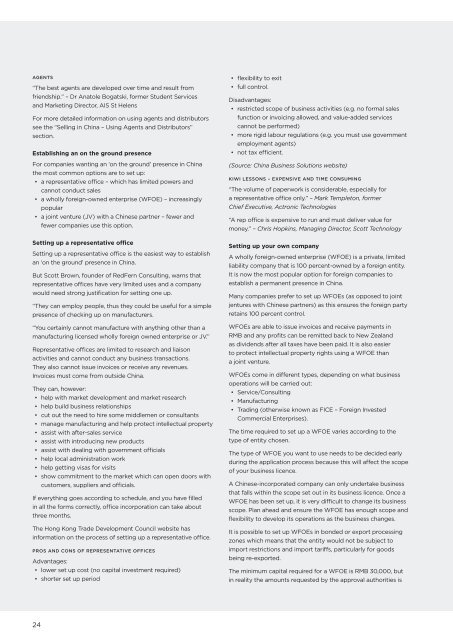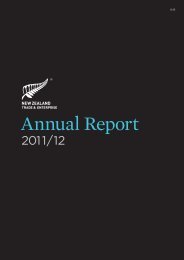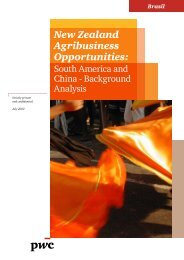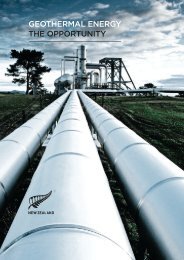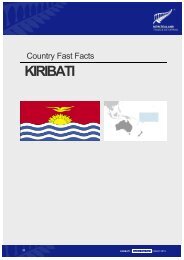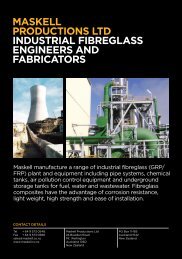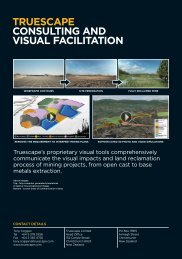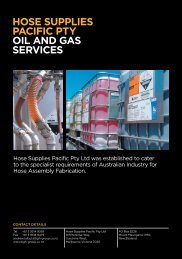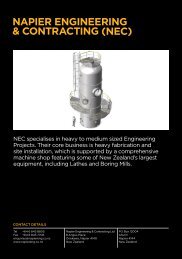Navigating China Guide (2012) - New Zealand Trade and Enterprise
Navigating China Guide (2012) - New Zealand Trade and Enterprise
Navigating China Guide (2012) - New Zealand Trade and Enterprise
You also want an ePaper? Increase the reach of your titles
YUMPU automatically turns print PDFs into web optimized ePapers that Google loves.
AGENTS<br />
“The best agents are developed over time <strong>and</strong> result from<br />
friendship.” – Dr Anatole Bogatski, former Student Services<br />
<strong>and</strong> Marketing Director, AIS St Helens<br />
For more detailed information on using agents <strong>and</strong> distributors<br />
see the “Selling in <strong>China</strong> – Using Agents <strong>and</strong> Distributors”<br />
section.<br />
Establishing an on the ground presence<br />
For companies wanting an ‘on the ground’ presence in <strong>China</strong><br />
the most common options are to set up:<br />
• a representative office – which has limited powers <strong>and</strong><br />
cannot conduct sales<br />
• a wholly foreign-owned enterprise (WFOE) – increasingly<br />
popular<br />
• a joint venture (JV) with a Chinese partner – fewer <strong>and</strong><br />
fewer companies use this option.<br />
Setting up a representative office<br />
Setting up a representative office is the easiest way to establish<br />
an ‘on the ground’ presence in <strong>China</strong>.<br />
But Scott Brown, founder of RedFern Consulting, warns that<br />
representative offices have very limited uses <strong>and</strong> a company<br />
would need strong justification for setting one up.<br />
“They can employ people, thus they could be useful for a simple<br />
presence of checking up on manufacturers.<br />
“You certainly cannot manufacture with anything other than a<br />
manufacturing licensed wholly foreign owned enterprise or JV.”<br />
Representative offices are limited to research <strong>and</strong> liaison<br />
activities <strong>and</strong> cannot conduct any business transactions.<br />
They also cannot issue invoices or receive any revenues.<br />
Invoices must come from outside <strong>China</strong>.<br />
They can, however:<br />
• help with market development <strong>and</strong> market research<br />
• help build business relationships<br />
• cut out the need to hire some middlemen or consultants<br />
• manage manufacturing <strong>and</strong> help protect intellectual property<br />
• assist with after-sales service<br />
• assist with introducing new products<br />
• assist with dealing with government officials<br />
• help local administration work<br />
• help getting visas for visits<br />
• show commitment to the market which can open doors with<br />
customers, suppliers <strong>and</strong> officials.<br />
If everything goes according to schedule, <strong>and</strong> you have filled<br />
in all the forms correctly, office incorporation can take about<br />
three months.<br />
The Hong Kong <strong>Trade</strong> Development Council website has<br />
information on the process of setting up a representative office.<br />
PROS AND CONS OF REPRESENTATIVE OFFICES<br />
Advantages:<br />
• lower set up cost (no capital investment required)<br />
• shorter set up period<br />
• flexibility to exit<br />
• full control.<br />
Disadvantages:<br />
• restricted scope of business activities (e.g. no formal sales<br />
function or invoicing allowed, <strong>and</strong> value-added services<br />
cannot be performed)<br />
• more rigid labour regulations (e.g. you must use government<br />
employment agents)<br />
• not tax efficient.<br />
(Source: <strong>China</strong> Business Solutions website)<br />
KIWI LESSONS – EXPENSIVE AND TIME CONSUMING<br />
“The volume of paperwork is considerable, especially for<br />
a representative office only.” – Mark Templeton, former<br />
Chief Executive, Actronic Technologies<br />
“A rep office is expensive to run <strong>and</strong> must deliver value for<br />
money.” – Chris Hopkins, Managing Director, Scott Technology<br />
Setting up your own company<br />
A wholly foreign-owned enterprise (WFOE) is a private, limited<br />
liability company that is 100 percent-owned by a foreign entity.<br />
It is now the most popular option for foreign companies to<br />
establish a permanent presence in <strong>China</strong>.<br />
Many companies prefer to set up WFOEs (as opposed to joint<br />
jentures with Chinese partners) as this ensures the foreign party<br />
retains 100 percent control.<br />
WFOEs are able to issue invoices <strong>and</strong> receive payments in<br />
RMB <strong>and</strong> any profits can be remitted back to <strong>New</strong> <strong>Zeal<strong>and</strong></strong><br />
as dividends after all taxes have been paid. It is also easier<br />
to protect intellectual property rights using a WFOE than<br />
a joint venture.<br />
WFOEs come in different types, depending on what business<br />
operations will be carried out:<br />
• Service/Consulting<br />
• Manufacturing<br />
• Trading (otherwise known as FICE – Foreign Invested<br />
Commercial <strong>Enterprise</strong>s).<br />
The time required to set up a WFOE varies according to the<br />
type of entity chosen.<br />
The type of WFOE you want to use needs to be decided early<br />
during the application process because this will affect the scope<br />
of your business licence.<br />
A Chinese-incorporated company can only undertake business<br />
that falls within the scope set out in its business licence. Once a<br />
WFOE has been set up, it is very difficult to change its business<br />
scope. Plan ahead <strong>and</strong> ensure the WFOE has enough scope <strong>and</strong><br />
flexibility to develop its operations as the business changes.<br />
It is possible to set up WFOEs in bonded or export processing<br />
zones which means that the entity would not be subject to<br />
import restrictions <strong>and</strong> import tariffs, particularly for goods<br />
being re-exported.<br />
The minimum capital required for a WFOE is RMB 30,000, but<br />
in reality the amounts requested by the approval authorities is<br />
24


